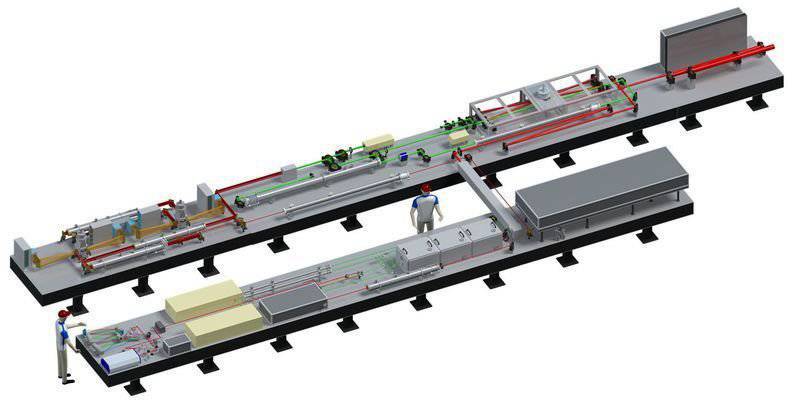The most powerful laser in history will be ready for 2017
Currently, scientists around the world are working to create a device that will become the most powerful laser in stories of humanity. According to experts, the most powerful laser ever created, which some have already dubbed the "Death Star", will allow scientists to make a large number of incredible discoveries. The new laser system will definitely find its application in medicine, biology, physics, materials science. Will help the new laser and astrophysicists in the study of various phenomena. For example, he will give people to understand exactly what processes occur in pulsars, brown dwarfs and exoplanets. Scientists hope that the new laser will allow them to reveal many secrets of the universe.
It is reported that the laser setup under the abbreviation HAPLS (High-Repetition-Rate Advanced Petawatt Laser System) will be 100 times more powerful than the Nova laser setup developed in 1984. A HAPLS laser will emit 100 thousands of times more energy than all the power plants in the world combined. In this case, the duration of his work will be only a tiny fraction of a second. The laser was nicknamed "The Death Star" by its wits for its resemblance to the laser weapons, which in the famous fantastic epic "Star Wars" used intergalactic villain Darth Vader.

ELI-HAPLS laser
Works on the laser are carried out as part of the Extreme Light Infrastructure (ELI) project, and were financed by the member countries of the European Union. At the same time, scientists and experts from all over the world took part in the work on the creation of this super-power laser facility. A laser is being built in the Lawrence Livermore National Laboratory, which is located in the US state of California. At the same time, the headquarters of this ambitious project is located in the Czech Republic. It is assumed that the first launch of the new laser installation should take place in 2017 year.
The HAPLS power setting will be more than one petawatt (10 to the fifteenth power of watts). She will be able to generate 30 femtosecond pulses with 30 MJ energy. The laser pulse repetition rate is 10 Hz, and the maximum radiation intensity of the entire installation is 10 of twenty-three degrees watts per square centimeter. According to experts, this is comparable to the level of energy that could be obtained by focusing all solar radiation on a very small 10 site on 10 centimeters. As if all the energy of the Sun suddenly concentrated in one ray the size of a bottle. Being under the beam of this laser at the time of its shot is not recommended to anyone, otherwise a person risks to feel in his own skin an action that is “brighter than a thousand suns”.
It is reported that the project ELI will be the world's first international research center for lasers. This makes it a kind of analogue of the famous CERN (European Organization for Nuclear Research), only designed to conduct all sorts of research on lasers, says Professor Wolfgang Sandner. The professor also stressed the fact that the creation of one of the most powerful lasers in the world will allow mankind to begin a new era of unique scientific discoveries and research for scientists from all countries of the world. It is assumed that this system will combine not only all the latest developments in Europe, but also the rest of the world.

Lawrence Livermore National Laboratory
Konstantin Hefner, a physicist and HAPLS project manager, also speaks about the possibility of making new scientific discoveries. According to him, scientists have long been engaged in conducting experiments with single powerful lasers, but never before have they had the opportunity to repeat their experiments with the speed of 10 once a second. According to the scientist, the HAPLS laser installation is able to produce ultrashort laser pulses, characterized by high energy levels, needed to accelerate charged particles (protons, electrons or ions), as well as to generate secondary sources of electromagnetic radiation, for example, x-rays of high brightness. It is reported that the laser unit HAPLS will include two laser systems interconnected. According to the available information, the Death Star will be mounted on an area around 17 on 4,6 m, approximately another 4 square meter will be used for the placement of the laser pulse compressor.
In the resonators of the HAPLS laser system, titanium-activated sapphire crystals are used. In the role of the installation management system, an improved version of the previous developments of the Californian laboratory engineers was chosen. To reduce optical aberrations in the laser, deformable mirrors and static wavefront correctors are used. The design of this laser installation was laid the possibility for the implementation of its further modernization.
Information sources:
http://www.thg.ru/technews/20140204_173312.html
http://gearmix.ru/archives/8974
http://fedpost.ru/sobytiya/44733-v-2017-godu-zvezda-smerti-sdelaet-svoj-pervyj-vystrel.html
Information